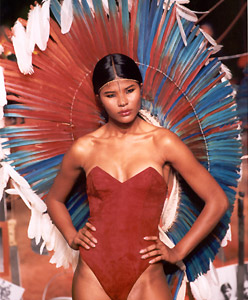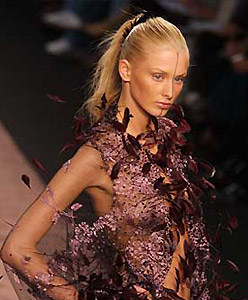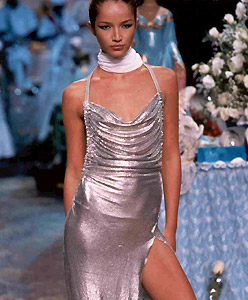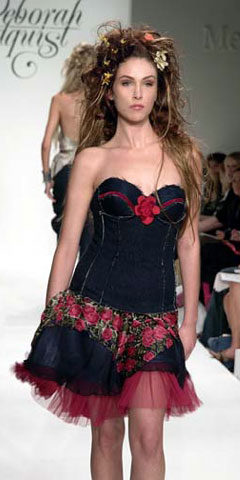| The Rise of Ecofashion
The Fashion eZine - Sustainable Fashion
A showcase for eco-fashion
It's the season for fashion to go green. With concern for the environment at a fever pitch, Canadian fashion designers are raising money for the conservation organization WWF-Canada with an eco-friendly fashion show. Helping the planet doesn't have to be painful, says Leslie Domenico, executive director of the Green Carpet Series which has organized An Evening of Sustainable Style at the Berkeley Church this Tuesday, which wants to attract local THUGS – Thoughtful Hip Urban Green-minded professionals. Green Carpet, a newly formed environment group, stages events to raise money and awareness. Its first event featuring organic food raised $10,000 in May. We "want to raise awareness and showcase alternatives in a fun way," says Domenico. They do this by promoting easy things people can do, such as buying clothing made of hemp or bamboo. "We are not preaching and not purists. Any shift in lifestyle helps," says Domenico. The clothes will be as good to look at as they are for the environment, says Domenico. Celebrity models, including television reporter Wendy Mesley and singer Melanie Doane, will model eco-friendly clothing by Canadian designers including Preloved, Yogagirl and Oqoqo as well as vintage items (remember, recycle and reuse.) TV personalities Gill Deacon and George Stroumboulopoulos are hosts. Linda Lundström, who is honourary chair of the event, has been designing environmentally friendly clothing for almost 20 years. After having her first child she grew concerned about dyes and chemicals used in the finishing of textiles, and how they affected the planet. Now Lundström works with eco-friendly materials such as bamboo as well as a material made out of recycled plastic bottles. Her two daughters, ages 20 and 16, will model her designs in the show. Money raised by Green Carpet will finance the WWF climate change education programs and conservation work. Recently WWF-Canada has focused on replenishing Canada's cod stock and other species affected by over-fishing says Tara Wood, public relations manager for WWF-Canada. Buying products made locally, including clothing, is one of the easiest ways people can help on the global warming file, says Wood. The fuel used to ship items from China or elsewhere uses up a lot of fossil fuels. Shopping locally not only produces less pollution, it helps local retailers and the Canadian economy, says Wood. Tickets for An Evening of Sustainable Style are $40 and available at greencarpetseries.com.
Eco-fashion finds a home in Brazil
SAO PAULO–For young Brazilians worrying about the latest fashions, the dangers of polluting rivers and oceans with billions of plastic bottles and tonnes of pesticides may seem a distant concern. But new technology that makes clothing from the polyester fibres of recycled bottles, and organic cotton grown without pesticides may prove that being environmentally conscious and staying hip can walk hand-in-hand. During last month's Sao Paulo Fashion Week, the biggest fashion event in Latin America, a group of local designers displayed several glamorous gowns made from recycled materials, known as e-fabrics. "It's a great idea. It's a way of educating people and making them think more about these issues," said Ruth Marshall-Johnson, an associate editor with the Worth Global Style Network research and fashion news service. The recycled bottles also are used to produce materials that serve as filling for matelasse fabric, ties and lapels. Collecting the bottles also generates income for thousands of poor Brazilian families. Technological fabrics will be responsible for great changes in the business, said Gloria Kalil, one of Brazil's top fashion consultants. "From now on, the industry will have to consider the environment. Otherwise, who's going to buy things that are damaging for the planet?" she said.
Marshall-Johnson agrees. She pointed out that the Internet has become a powerful tool for consumers to investigate whether what they wear utilizes slave labour or involves fabrics produced in a manner that is not ecologically friendly. Commercially, producing certain e-fabrics such as organic cotton could cost consumers up to 20 per cent more. "Organic cotton costs more to grow, but people don't realize that regular cotton is the worst crop for the environment because of the amount of pesticides it requires," said researcher Selma Fernandes, from the Institute E, a non-governmental organization sponsoring the fabrics project. "These pesticides end up killing butterflies and birds and pollute rivers." This year, designer Raquel Davidowicz, of the fashion house UMA, created her first collection of clothing for the catwalk made from organic cotton and bamboo fibres. "We were looking for new fabrics and chose these exactly because they are not harmful for the environment," Davidowicz said. "We are aware that they are trickier to sell." Specialists say it might take five years for the trend to catch up and for more people to start to pay the premium price for clothes made from e-fabrics. "The designers were interested in taking part in this project. Now we hope to create the desire among consumers to purchase this type of clothing," Fernandes said.
Trash To Fashion becomes an international event
Appropriately located in the heart of New Zealand's Eco-City, this event focuses on sustainability and environmental issues through fashion design competition. This year it reached new heights of recognition and artistic quality. Trash To Fashion delivered its promise of showcasing glamour and creativity from recycled materials to nearly 4000 attendees at this year's event held at the Trusts Stadium in Henderson, Waitakere. Over the past 11 years this event has grown to the point where it attracts international entries which this year included several from the US and one from Australia. National entries range the whole of the North Island as well as the South Island. Eight categories were presented throughout the show, interspersed with artistically performed interludes which followed a continuous narrative. Supreme and multi-award winner Amethyst Parker enthuses "I love this event, I've entered three times previously because it really pushes my thinking on what materials can be used in new and exciting ways so it makes me be resourceful. I think that's important for stimulating design and creativity .I also love the fact that these awards introduce new people to sustainable living and design." In addition to her other wins Amethyst received a special prize at the awards which recognised her exceptional abilities in creative design and will aid her quest for design excellence - $2000 worth of study grant donated by UNITEC. Some of the more unusual materials utilised by finalists this year included 1960s doll faces, a bird cage, garden hoses, bicycle parts, Xrays and also American yoghurt tops.
|
|
|
Recycling Urban Eco Fashion
An eco epicurean fashion boutique based on the joys of clothing recycling, Junky Styling has gained an international mystic with its creative one-off styles. Recycled sustainable eco fashionSaunders and Seager are not designers by training but rather stumbled into designing their own clothes to save money for traveling. The originality and freshness of their designs plus the environmental friendliness of recycling clothing quickly popped them into eco fashion awareness. Saunders and Seager have developed a design style based upon their destroy, repair, enhance, and reform approach which they call “Wardrobe Surgery”. They take old, recycled, donated clothing and deconstruct it removing parts of it such as sleeves, lapels or panels and then reconstruct the remaining bits by moving seams, reassembling sleeves as leggings, or perhaps a sleeve turns into a torso when opened out. And then they might add bits of details such as ruffles on shirts and cuffs on trousers from other recycled clothes. Saunders and Seager might become the Picassos of eco fashion. recycle eco fashion at Junky StylesClients and customers of Junky Styling range from young eco warriors to matronly art society ladies searching for the new “look.” While Junky Styling closely embraces recycling, one of the touchstones of the environmental movement, Seager has stated “we are obviously eco friendly but our main drive was to create and produce beautiful clothing.” We are beginning to find more and more environmental principles being incorporated into fashions and other industries. Miguel Adrover Saunders and Seager are not the only designers incorporating environmental and recycling principals into their fashions. New York’s Miguel Adrover has added ammunition belts to ladies fashions to emphasize the plight of indigenous tribes fighting for their lands in the Amazon rainforests and being forced out by American oil companies. Miguel Adrover has also used recycled fabrics such as a mini skirt made from an old Louis Vuitton handbag and plaids found at flea markets in some of his big New York shows.
Deborah Lindquist Deborah Lindquist recycled eco fashionDeborah Lindquist, Los Angeles designer for the celebrities, “reincarnates” old and vintage clothing and accessories by recycling them into reconstructed one-of-a-kind eco haute couture. Lindquist transforms her love of the environment by recycling old cashmere, saris, kimonos, scarves and other old bits and pieces into her environmentally-sensitive wearable eco art. Corsets and bustiers are a trademark of Lindquist. Lindquist makes a fashion and environmental statement by using recycling to reincarnate, renew, and transform the old into new beauty. According to Lindquist, "I want to do my best to take care of the planet by designing with recycled and eco-friendly materials. I think we all have to start with what we know because it can seem like a daunting task since I feel the world is in crisis. I design clothing, so I figured I'd start there." Lindquist says she loves the strange and beautiful details that each recycled piece brings to her creations. "Instead of getting a bolt of fabric that anyone down the block could buy, using recycled materials creates a more individual look." So, what does this have to do with organic clothing? Directly, not much; but indirectly, quite a bit. Recycling is important for reusing and conserving natural resources. Organic clothing is important in reducing chemical toxins found in conventional fertilizers and pesticides and from garment manufacturing processes. If you think of the environmental movement as being a large tree dedicated to improving the health of our planet and all life, then eco-friendly fashion and organic clothing are like two large branches of the Tree that each have smaller branches that intermingle and come together sometimes. For example, both recycling fashion and organic clothing could be called eco sustainable fashions. Organic purists decry that not all eco fashion is healthy. And fashion mavens sniff that not all organic clothing is fashionable. But both contribute to improving the health of the planet, sometimes in different ways and sometimes in the same ways. This is one of the features of the environmental movement that give it vibrancy and relevancy.
| |





